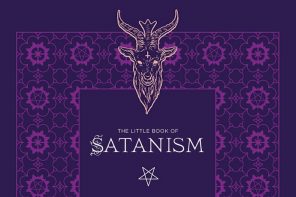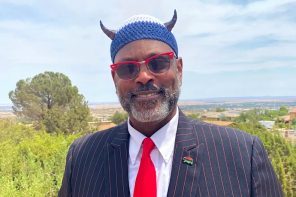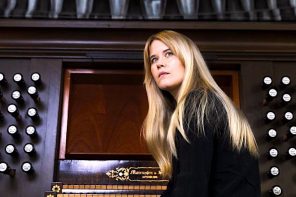When the Satanic Temple offered to perform a historical re-enactment of a black mass through the Harvard Extension School Cultural Studies Club, no one had any idea what a media circus would ensue. The event was originally intended as a lecture on the history of legends surrounding the black mass followed by a performance. The idea was similar to the 1922 film Haxan: Witchcraft Through The Ages, which informed the audience about early modern beliefs about the devil featuring actors portraying a witch’s Sabbath. But an unusual lecture quickly became national news when Catholic critics decried it as Harvard-sponsored hate speech.
By Monday night when the event was scheduled to occur, it had been denounced by Harvard president Drew Faust, Harvard chaplains, and the Archdiocese of Boston. A petition protesting the event was signed by 60,000 students, faculty, and alumni; an estimated 1500 Catholics protested with a holy hour and a Eucharistic procession down Massachusetts Avenue; and spokesperson Lucien Greaves says he received numerous death threats. In the aftermath, I spoke with Greaves about the intentions behind the black mass and what would have happened had the event been allowed to take place as planned.
The Satanic Temple is best known for political campaigns that demonstrate the wisdom of separating church and state—such as their plan to erect a monument to Baphomet next to the Ten Commandments monument in front of Oklahoma’s capital. But the Satanic Temple’s members are more than political atheists with a gimmick. Although they reject supernaturalism, they comprise a community that values self-determination and finds meaning through a shared tradition of ideas and rituals. In the past, Greaves has been invited to speak about his perspective in comparative religion classes at Harvard and has been well received. The black mass, he claims, was not a bid for media attention but an honest attempt to educate an audience about how Satanists see the world.
Had the black mass proceeded as planned, it would have been about two hours long, with the first hour devoted to an educational lecture and the second half to a performance. There would have been a short speech by Harvard ethicist Christopher Robichaud about how we define such ideas as hate-speech and tolerance. There would have been a lecture on the history of the black mass, which is generally assumed to have been invented in early modern France. Speakers would also have talked about how societies throughout history have imagined elaborate conspiracies involving the performance of evil rituals in order to shore up their own sense of an ordered, moral universe. Finally, the Satanic Temple would have explained that while self-proclaimed Satanists generally do not perform black masses, Satanists employ “blasphemy” as a declaration of independence from superstition and arbitrary authority.
Because Satanists come from societies saturated by Christian symbols and culture, they repurpose these symbols to give ritual expression to their dissent. Their use of Satanic imagery might be compared to communist Cuba where street youth spray-painted the Nike swish in public places. The graffiti was not meant to endorse Nike. Instead, they took a symbol of the capitalism that the regime taught was evil and used it to voice their dissent. From this perspective, the black mass is less about attacking Christianity and more a form of bricolage or creating a new cultural form from the materials at hand.
The second half would have been a performance of a black mass based on descriptions from the nineteenth-century French novel La-bas. Two actors dressed as a nun and a priest would have performed a ritual in liturgical Latin. A prop representing a communion wafer would have been stepped on or otherwise defiled. It was this last detail that became the focus of the controversy.
A number of Catholics, including Patheos blogger Elizabeth Scalia, contacted The Satanic Temple to ask whether a real consecrated wafer would be used. Greaves insists that he stated categorically that a consecrated host would not be used, though an earlier mix up involving a Temple spokesperson unfamiliar with Catholic terminology, combined with Greaves’ effort to point out that for the Temple’s purposes consecration—a “supernatural” designation—is meaningless in any case, left many critics with lingering suspicions. He explained he was “not sympathetic” to complaints from Catholics who seemed uninterested in dialogue and placed the onus entirely on the Satanic Temple to avoid offending them.
As the controversy spread, representatives of Harvard asked Greaves if he could simply use an “imaginary” communion wafer or even a piece of broccoli in lieu of bread. Greaves found the idea of offending broccoli intriguing, noting that to atheists, blasphemy is inherently ridiculous. However, he ultimately rejected it. In fairness, Greaves notes that he was never given a formal ultimatum about how the black mass had to proceed.
The venue became the official reason for cancelling the event. Originally, the black mass was scheduled for an audience of 100. But the controversy attracted interested parties from out of state. Twenty reporters wanted to attend. Even though the full capacity of the Queen’s Head pub is closer to 300, the ceremony was moved off campus.
The Cultural Studies Club offered to rent The Middle East, a nearby nightclub that has featured burlesque acts and heavy metal shows. But only hours before the black mass was to start, the Middle East pulled out. (There were rumors that influential opponents of the black mass had threatened to send fire marshals and health inspectors if the event went forward.) Finally, a rather ad-hoc version of the black mass took place at the Hong Kong lounge in Harvard Square.
As Christopher Robichaud noted, the black mass fiasco points to a larger discussion about religious pluralism, tolerance, and free speech. Critics compared the black mass to a “re-enactment” of a KKK rally or a Quran burning being passed off as a celebration of multi-culturalism. Greaves countered that this is not an apt comparison: The KKK and Quran burnings are historical realities and were used to oppress minorities. The black mass was a fantasy promoted by the religious majority to demonize opposition. Greaves compares his appropriation of the black mass by modern Satanists to rappers referring to themselves by the “n-word” to voice their experience of structural injustices.
There is, of course, room for debate about whether an atheistic ritual centered around blasphemy is appropriate for an event series intended to celebrate multi-culturalism. But in this case, the opportunity for debate and reflection was squandered. The overwhelming majority of Catholic demonstrators, including the Archdiocese of Boston, made no effort to learn what the Satanic Temple intended to do or what their motivation was. Instead of engaging the Satanists in a reasoned and civil debate, dissent was effectively silenced.
Greaves noted the irony that his Catholic critics regarded themselves as an embattled minority even as his inbox filled up with “more than a lot” of death threats. Perhaps the real “educational value” of the black mass is the realization that we are still discovering how to foster the values of pluralism and tolerance even when other people’s views strike us as frightening or offensive.




